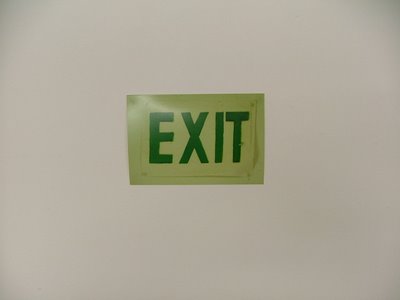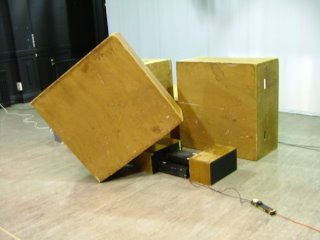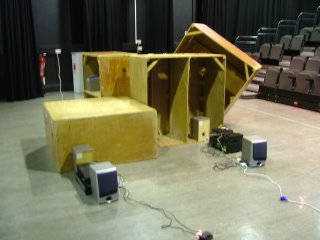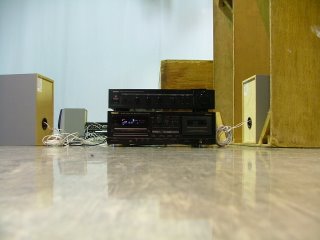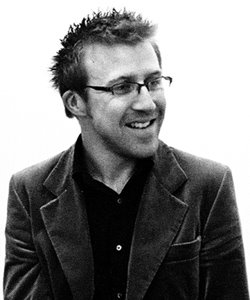
Questions sent to Mole Wetherell Artistic Director of Reckless Sleepers re: Last Supper 20 November 2006:
1. How do you deal with the idea of last-ness?
2. How do you deal with the idea of absence?
3. How do you deal with missing information?
4. How do you deal with the words of the dead?
5. How do you deal with the gigantic details (or the massive narratives)?
Answers received 29 November 2006:
Last - there is a predictability about the Last Supper, or the last meal requests, to know the number of seconds left in your life must be a terrible thing, to know that you will no longer eat anything because this will be your last, its planned, its no accident, it is going to happen...
Its very present, and very much about something that will happen in the future, In this respects its very orchestrated, or choreographed, I am sure that there are a whole number of rituals that go with an execution, it is very planned, And i get an impression, that it isn't a very upbeat experience.
There is a drama about knowing that something is going to happen...to another person, I cant imagine for a minute what those last things are like, I remember on a school trip we wen through the Doges palace, through the bridge of sighs, which is the last view of the outside world that prisoners get, before they are executed, executed between the statues of the devil and the deep blue sea, but then i remember having a series of firsts, i think that it might have been 1984 with my friend Neil and i had my first cigarette of 1984, my first cup of Tea, told my first joke, laughed for the first time and crossed over the road in a minor drunken fashion, for the first time.
I've had my last drink, and that is the last thing that i will say about that.
Its late its not that late, but i don't want to make too much noise,
In the Last Supper there are several references (i had to go for a walk to the kitchen to get that Last word in my brain) references to Last, Last meal requests, last words, last moments, Last works, painters musicians, there is a whole series of last compositions, which was created by Gerrit especially for the last supper, so we
have within the piece the last composition (unfinished) by Mozart, the film score from the last film that James Dean was in, the list is long
There are 19 tracks in total, but in the last supper, its not just about the last words, there is a morbid fascination with them, and plenty of sources of information about last words or last statements, and for some its important to know, but these may be the last words uttered by someone in a morphine state, not making much sense, but we hang onto these last words as if they were precious, as if these words will continue to live on, like the maid who was asked what were Einstein's last words and she said I dont know i dont speak, German...
For me my favourite last words are the ones that I have invented, and it starts with Newton, - Marylyn Monroe - Einstein with Newton his last words seemed fake, they seemed fabricated too complete too long winded, and so what we get from Tim is what was an improvised section, but is now clearly set,
Newton - his last words
Tim - I dont know? I dont know how to, i dont know what i may seem to the rest of the world...and then he rambles on, its pretty much set, but has the impression that this might take a long time, he is gently
interrupted, By
Leen: Norma Jean Mortenson"
Mole: Later"
Leen: Norma Jean Baker"
Mole: Later
Leen: Marylyn Monroe
Mole: Later
Leen: around 10 A.M. Wearing nothing but channel no 5, a telephone in
one hand...Jo...Jim...Arthur..Jim...
Mole: Lying in his deathbed, Albert Einstein a flashback to his early youth making little sense in German, refusing to take morphine so that he can think straight, see straight, think of one last thought...
(i have the whole text of this I send it...
These are fabricated moments and idea of what might have been their last moments, its a very sad moment in the piece, because there is a sense of loneliness with this part, its MM calling to her X husbands and lovers, alone.
I felt a real sadness there because my mother died this year, i wasn't around when she died, i went to get a cup of tea from the hospital canteen, whilst the nurse was busy, we came back and she had gone, I think that she had waited,
But i know what her last words were, and it wasn't anything grand, or huge or massively important, it wasn't what she said, it was how she said it, My mum was a nurse and she worked worth old people so she knew the ropes, she knew the drugs routine or ritual, and she refused to take the morphine, i could see it in her eyes she didn't want to give this life up, she wasn't ready to go yet.
And so her last words take their place in the new version of The Last Supper,
That may be the Last Time that i mention this,
My mum, and the reason why i bring her into the last Supper is that she is everywhere in it, her favourite perfume Channel No 5 the last bottle that i bought her for Christmas has replaced the one that we lost in that place, her birthday is July 14 Bastille and when she came to see the performance as the Marseilles is playing in the
background on the announcement of the largest of the last meal requests, the Birthday Cake, it seems fitting that my mum should get the Birthday cake, which she did.
My Dad who was dying when i was writing the last supper isn't in the Last Supper, there is a moment in Spanish Train where i always think of him, and there is a moment in The Last Supper when i will always think of my mum,
So
Question 2,, there is a sense of absence, a strong sense for me of people who arent there any more, its more prevalent for me because ive lost 2 very close people in my life, very recently, so i cant put this Last Supper show to bed, to sleep as it were its too relevant for me at this moment in my life.
We do start with a, no we dont we start with people choosing a seat a bingo ticket, the performance starts with a toast, which starts with I am ready which was someone's last words, or its the most common last words before an execution.,and then we toast those who arent there any more, a list of nicknames to Al Tikriti (Sadam Hussein), To
shy Di (Diana Spencer) these are familiar names, and i always think of the New year celebrations, not like my first crossing the road, but the strange dance that is done, or was done, in the house parties that we used to have, in the 1970's and 1980's (early)
And i always had to first foot, there was no coal, but i always had to go outside at 12 and ring the bell and be let into the house even though i had a key and even though i dont even think the door was locked any way, but there is something nostalgic about the last supper, there is something about not being there also, about only really understanding these moments as a witness,
These are people who are not here any more but we still celebrate their Ideas, Relativity was 100 years old recently it was Mozart's 400th Birthday, and we are still bound by Newtonian physics, Gravity still exists so far many of the celebrities their ideas or work are still relevant, or celebrated they arent here but we still remember them, the prisoners however are different, this is the strange thing
about the Last Supper as there are moment within this piece where the audience or visitors reaction amazes me, for instance the food when presented normally gets a small applause or laugh, after the candles are blown out of the birthday cake this action receives applause, and yet these are the last requests of someone who isn't around any more, and this meal has everything to do with death, is celebrated,
Of course this isn't wrong.
Absence,
I like that gaps are left to be filled, and what im trying to say here is that i dont think its necessary to say everything and these absences are crucial to the last supper (we the audience fill in the gaps) well i hope that we do, i always have an image of MM and Napoleon and Einstein playing in my head when i speak or hear these
descriptions.
Missing Information, well, we cant know everything can we, i dont have a clue what you thought when you read that last line, you perhaps smiled as i am now, well im imagining you smiling, we cant know everything and we cant describe everything, we cant describe how to move across the room, i cant describe every painting in Van Goughs room the one where he died, the room that he painted with the small single bed and a couple of Van Gough chairs in there and i think on the walls there is a painting of sunflowers or a vase and a filed there's a small window, and i imagine that his brother in the room holding his hand.
Im not saying everything there that happened, but im trying to do is paint a picture plant an image in your head, so that you can move the scene on you can imagine it, and i think that is what i really like about the last supper, there is too much information at times, dates and locations, and thats not theatre its a list of who said what and where and when and you can but that in a book.
This is why i like the Newton-MM-Einstein part because we dont really have any information about what happened, just someone else's impression, in The Romanovs we have too much information so much so that the room is filled with the noises of the information that we have, and in a way this is used like a machine we broadcast as much information as we can, and what we have is half of what information that we have as i cut so much of it because there was too much information about where a person was shot what happened how they fell, pages and pages or accounts of what happened, and so i deal with that by editing it out,
In Che we had many conflicting ideas about what actually happened and what he said, so we show this, Franz Kafka wrote his last words on small pieces of paper, which we have (the small pieces of rice paper that we eat) JFK 'thats obvious" was his last words, but we are so familiar with the events surrounding his death that we dont have to say that much, Lee Harvey Oswald follows "I have nothing more to say to you"
The wicked witch is the only fictional character in the Last Supper, Sadam Hussein No 2, 3, and 4 dont have jobs any more Saddam Hussein No. 1 is now on death row. i dont know what im saying here perhaps you can make sense of it tomorrow..
Dealing with the words of the Dead, I dont put too much weight on them, i dont hold on to it any way, and part of me doesn't quite believe what passes as credible research as fact, in the original LS we found the last words of Oscar Wilde, iN Paris in a hotel room which were quoted as either that wallpaper goes or I do, well after
a bit of time and some space id had time to read the final pages of the biography of Oscar Wilde whos last words were reportedly My Wallpaper and i are fighting a duel to the death, one or the other of us will have to leave, which sound more credible, but no one got it, people used to hear the quick wit of the first, and the second just
didn't work so Oscar isn't in it any more, well he might be if we ever do the show in Paris. Because if we did the show in Paris there would be plenty of references that we could link in.
I think that we are pretty sympathetic about how people are presented, Bobby Sands we keep to his last diary entry its such a strong piece of text, and there are so many associated images surrounding that whole time that its always very strong.
In The Hiroshima scene we eat 38 last statements in quick succession were not pointing a finger at anyone, and again this is a scene that doubles our visitors laugh at this scene because we find it difficult to speak, but then there is normally a realisation that these are the last words of people in a city, and this really happened, and it can happen to us, i could have easily said 9/11 or Tsunami, or another event in history,
So the words themselves arent that important to me, and i dont trust many of them I'm suspicious that many of them, especially Victorian reports of last words are jokes, rewritten modified, I believe John Lennons, JFK's and Kafkas last words, so they are in, but we dont even Know what Elvis's last words were so we dont say them, and no
one seems to mind,
The Last bit, i think what i want to say with the last supper is that the massive narrative is that this happens again and again throughout history we go through the same conflicts and same arguments and the same love affairs and the same things happen and we all have one last thing to say,
And that cycle of history repeating itself is very clear to me.
French Revolution - Russian revolution - Velvet Revolution - Invasion of Iraq - Civil War
Scapegoats and executions
Marie Antoinette - Tsar - JFK - Sadam - so this for me is the big narrative, and then the smaller things are the bigger things too like the small conversations in the Hiroshima scene, MM desperate to speak to someone, Andy Warhol on the Phone to his brother Van gough holding his brothers hand.
